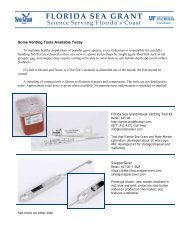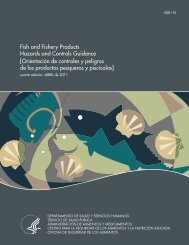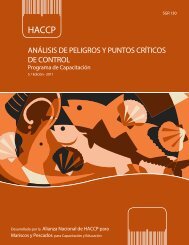HACCP
Hazard Analysis and Critical Control Point - Florida Sea Grant
Hazard Analysis and Critical Control Point - Florida Sea Grant
- No tags were found...
Create successful ePaper yourself
Turn your PDF publications into a flip-book with our unique Google optimized e-Paper software.
Chapter 2<br />
Table 1 (cont.)<br />
Corrections:<br />
a) Unapproved chemicals are returned or used in non-processing areas.<br />
b) Improperly stored chemicals are moved to the correct storage area.<br />
c) Safety of the product is examined and contaminated source is eliminated.<br />
d) Repairs are made as needed to defective equipment.<br />
e) Sanitation supervisor corrects any condensation problems.<br />
Records:<br />
a) Periodic Sanitation Control Record.<br />
b-e) Daily Sanitation Control Record.<br />
6) Labeling, storage and use of toxic compounds (FDA Key Sanitation Condition<br />
No. 6)<br />
Controls and Monitoring:<br />
a) All toxic compounds used in the plant are labeled with the manufacturer’s name,<br />
use instructions, and the appropriate EPA approval, or have documentation with<br />
the necessary information. Receiving manager verifies that this information is<br />
present before toxic compounds are stored. Monitoring Frequency: When toxic<br />
compounds are received.<br />
b) Cleaning compounds, sanitizing agents, lubricants, pesticide chemicals, and<br />
other toxic compounds are properly labeled and stored in a closed and locked<br />
cage in dry storage outside processing and packaging areas and separately from<br />
food-grade chemical, food-grade lubricant, and packaging material storage.<br />
Only authorized personnel have access to the cage. Sanitation supervisor checks<br />
cage for cleanliness and container leakage. Monitoring Frequency: Daily before<br />
operations.<br />
c) All manufacturers’ instructions and recommendations are followed. Only<br />
authorized personnel fill small working containers, such as containers of hand<br />
sanitizing compounds. These containers are properly marked with the common<br />
name of the chemical and are not stored in any way that may cause the chemical<br />
to fall or drip onto food or food-packaging materials. Sanitation supervisor verifies<br />
proper procedures and labeling. Monitoring Frequency: Daily before operations.<br />
Corrections:<br />
a) Toxic compounds without proper information are placed on hold until information<br />
is obtained. Toxic compounds without documentation are returned to the supplier.<br />
b) Improperly stored chemicals are moved to the correct storage area. Leaking<br />
containers are resealed or replaced as necessary. Storage cage will be cleaned by<br />
the next working day.<br />
c) Misuse of toxic compounds results in disciplinary action or retraining. Potentially<br />
contaminated food is discarded or destroyed. Improper labeling of working<br />
containers is corrected.<br />
Records:<br />
a) Periodic Sanitation Control Record.<br />
b-c) Daily Sanitation Control Record.<br />
24








